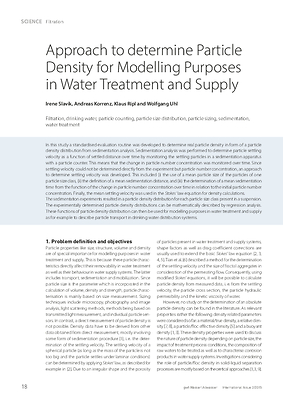Approach to determine Particle Density for Modelling Purposes in Water Treatment and Supply
Thema:
Publikationsform: Fachartikel
Artikelnummer: 05399_2015_SP2_01
Zeitschrift: Approach to determine Particle Density for Modelling Purposes in Water Treatment and Supply
Erscheinungsdatum: 01.01.1970
Autor: Irene Slavik / Andreas Korrenz / Klaus Ripl / Wolfgang Uhl
Herausgeber: In this study a standardised evaluation routine was developed to determine real particle density in form of a particle density distribution from sedimentation analysis. Sedimentation analysis was performed to determine particle settling velocity as a function of settled distance over time by monitoring the settling particles in a sedimentation apparatus with a particle counter. This means that the change in particle number concentration was monitored over time. Since settling velocity could not be determined directly from the experiment but particle number concentration, an approach to determine settling velocity was developed. This included (i) the use of a mean particle size of the particles of one particle size class, (ii) the definition of a mean sedimentation distance, and (iii) the determination of a mean sedimentation time from the function of the change in particle number concentration over time in relation to the initial particle number concentration. Finally, the mean settling velocity was used in the Stokes’ law equation for density calculations. The sedimentation experiments resulted in a particle density distribution for each particle size class present in a suspension. The experimentally determined particle density distributions can be mathematically described by regression analysis. These functions of particle density distribution can then be used for modelling purposes in water treatment and supply as for example to describe particle transport in drinking water distribution systems.
Verlag: DIV Deutscher Industrieverlag GmbH
Publikationsformat: PDF
Themenbereich: gwf - Wasser|Abwasser
Details
In this study a standardised evaluation routine was developed to determine real particle density in form of a particle density distribution from sedimentation analysis. Sedimentation analysis was performed to determine particle settling velocity as a function of settled distance over time by monitoring the settling particles in a sedimentation apparatus with a particle counter. This means that the change in particle number concentration was monitored over time. Since settling velocity could not be determined directly from the experiment but particle number concentration, an approach to determine settling velocity was developed. This included (i) the use of a mean particle size of the particles of one particle size class, (ii) the definition of a mean sedimentation distance, and (iii) the determination of a mean sedimentation time from the function of the change in particle number concentration over time in relation to the initial particle number concentration. Finally, the mean settling velocity was used in the Stokes’ law equation for density calculations. The sedimentation experiments resulted in a particle density distribution for each particle size class present in a suspension. The experimentally determined particle density distributions can be mathematically described by regression analysis. These functions of particle density distribution can then be used for modelling purposes in water treatment and supply as for example to describe particle transport in drinking water distribution systems.
Preis: 4,90 €Zum Shop
